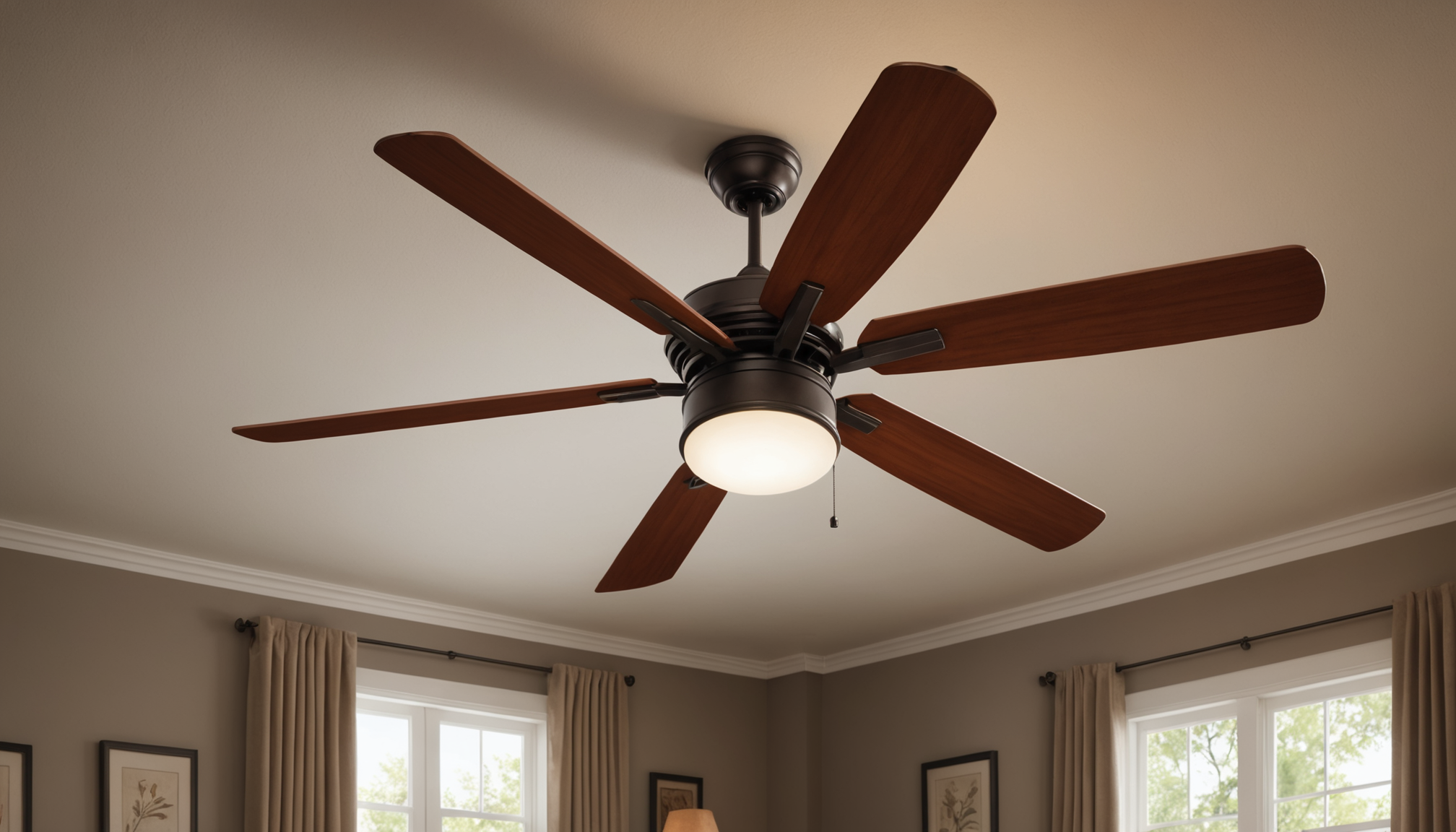When it comes to choosing between ceiling fans and portable fans, understanding their airflow efficiency is critical for making an informed decision. Airflow efficiency relates to how effectively a fan circulates air within a space, contributing to the comfort and climate control of your environment. Both ceiling and portable fans can move air, but they do so with varying degrees of effectiveness, depending on their design and power capabilities.
Ceiling fans are designed to circulate air efficiently across larger areas. They are mounted on the ceiling, which allows for a broad spread of airflow throughout an entire room. One of the distinguishing features of ceiling fans is their large blades, typically spaced several feet apart, allowing them to move a high volume of air with each rotation. The height and central positioning in a room enable ceiling fans to create a downdraft or an updraft, depending on the direction of blade rotation. This flexibility is particularly useful for optimizing airflow throughout the year–a downdraft can cool a room in the summer, while an updraft can help to distribute warm air more evenly during the winter months.
Portable fans, on the other hand, are generally more localized in their airflow distribution. They come in various sizes and styles, such as box fans, tower fans, and desk fans, each offering different levels of efficiency. Due to their size and mobility, portable fans are best suited for targeting specific areas or individuals. They may not be able to circulate air as thoroughly as ceiling fans, especially in larger rooms; however, their concentrated airflow can provide immediate relief and flexibility in various settings.
To offer a clearer comparison of the airflow efficiency between ceiling fans and portable fans, consider the following table, which outlines key aspects of each type of fan:
| Aspect | Ceiling Fans | Portable Fans |
| Installation Location | Permanent, ceiling-mounted | Mobile, can be placed on the floor or a surface |
| Coverage Area | Entire room, ideal for large spaces | Localized, best for small spaces or direct airflow |
| Airflow Volume | High | Varies by model; generally lower than ceiling fans |
| Adjustability | Can switch between downdraft and updraft | Typically adjustable in direction and speed |
Ultimately, the choice between ceiling and portable fans depends largely on the intended use and the specific needs of the environment. If the goal is to cool a large area efficiently and subtly without occupying floor space, ceiling fans have the upper hand. Meanwhile, for individuals seeking flexibility and directed airflow, portable fans prove to be a practical, adaptable choice.
energy consumption analysis
When evaluating the energy consumption of ceiling fans versus portable fans, it’s essential to understand how each type of fan impacts your overall energy usage and costs. Here’s a step-by-step analysis of the energy consumption considerations for both.
1. Wattage Usage:
– Ceiling Fans: Typically, ceiling fans consume between 15 to 90 watts, depending on the size and speed settings. Larger fans with longer blades might use more energy, especially at higher speeds, but they also cover a wider area. However, even at their most energy-intensive setting, ceiling fans are generally quite efficient compared to air conditioning units.
– Portable Fans: These fans usually operate within a range of 30 to 100 watts. Smaller personal fans will be on the lower end, while larger tower fans or air circulators may reach higher wattage. The energy demand also varies based on the features available, such as oscillation or additional speed settings.
2. Operational Time and Patterns:
– Many people use fans continuously throughout the day and night, especially during warmer months. Understanding your usage pattern will help you estimate potential energy costs.
– Ceiling Fans: These are often left running for extended periods, as they are less noticeable and more unobtrusive in their operation. Due to their design, they can run for hours with minimal energy waste when used correctly.
– Portable Fans: Users may turn them on and off more frequently since they are easy to access and control, which could potentially lead to energy savings, especially if only used when needed.
3. Cost Implications Based on Energy Rates:
– To calculate the monthly cost of running these fans, consider the average energy cost per kilowatt-hour in your region. For instance, if the rate is $0.13 per kWh, running a 75-watt ceiling fan for 8 hours a day might cost around $2.34 per month.
– Conversely, the cost for a 50-watt portable fan used for the same duration might amount to about $1.56 per month.
4. Efficiency Enhancements:
– Ceiling Fans: Opt for ENERGY STAR-rated models to ensure maximum efficiency. These fans are approximately 60% more efficient than standard models due to improved motor and blade designs.
– Portable Fans: Look for models with energy-saving features such as timers, remote controls, or eco modes that reduce power drain without compromising on comfort.
5. Supplementary Cooling Considerations:
– Fans, whether ceiling or portable, are most effective when used as a supplement to air conditioning. By circulating air effectively, they can make rooms feel up to 8 degrees cooler, allowing you to raise the thermostat setting and save on energy costs from your cooling system.
In summary, understanding the energy implications and operational characteristics of both ceiling and portable fans will help you make an informed decision suited to your efficiency needs and budget. Although the energy consumption of both types is relatively low, choosing the right fan according to your pattern of use and space requirements can lead to substantial savings in the long run.
noise level considerations
When choosing between ceiling fans and portable fans, noise is a crucial consideration for many users looking to maintain a tranquil environment while staying cool. Fans that operate quietly are especially important in areas where concentration or relaxation is desired, such as bedrooms, home offices, or living rooms.
Ceiling Fans:
One of the standout benefits of ceiling fans is their generally quiet operation, especially when compared to many portable fan models. Their design and placement contribute significantly to this. Being mounted on the ceiling, any noise they produce is less likely to propagate directly towards people in the room. Modern ceiling fans, particularly those labeled as “silent” or “whisper-quiet,” incorporate advanced blade designs and efficient motors that minimize noise. These enhancements ensure that ceiling fans can operate at low decibel levels, making them ideal for overnight use or in spaces that demand minimal noise interference. However, it’s important to note that noise levels can vary based on the fan’s speed setting and how well it is installed–an improperly balanced or poorly mounted fan might produce more sound.
Portable Fans:
Portable fans, due to their close proximity to users and varied motor types, have a broader range of noise outputs. Desk or tabletop fans tend to be quieter due to their smaller size and focus on minimal power usage. Conversely, larger units like tower fans or pedestal fans often possess more powerful motors; though efficient, these can create noticeable noise, especially at higher speed settings. As a result, portable fans might not always be the best choice for noise-sensitive environments. However, they do offer more control over operation settings, and selecting a fan with multiple speed options can mitigate noise concerns by allowing lower-speed (and quieter) settings when needed. Some models are specifically designed with “quiet modes” or feature insulated casings to help reduce the overall sound output.
Innovative Technologies:
In recent years, both ceiling and portable fans have seen a slew of innovations geared toward reducing noise. Brushless DC motors, which are often quieter and more energy-efficient, have become popular in many advanced fan models. This technology, along with improved blade aerodynamics, allows fans to push more air with less noise. Furthermore, manufacturers have begun to market models with specialized sound-dampening technology, making it easier to find options that prioritize a quieter operation.
Overall, when noise is a primary concern, choosing a ceiling fan often yields a quieter experience, particularly for whole-room air circulation without individual adjustments. Yet, selecting quiet-themed portable fans can still provide satisfactory results for localized cooling needs. Understanding the noise characteristics of both fan types and recognizing advancements tailored to noise reduction can significantly enhance your decision-making process, ensuring comfort without compromise on tranquility.
cost and installation factors
When comparing ceiling fans and portable fans, cost and ease of installation are vital factors to consider. Understanding these aspects can significantly influence your decision, especially if budget constraints are a concern or if you prefer a hassle-free setup.
Ceiling fans typically have higher upfront costs than portable fans. They require a more significant investment because of their larger size, more complex design, and the need for professional installation. On average, a good-quality ceiling fan can range from $100 to $500 or more, depending on features like lighting integration, advanced remote controls, or energy-efficient motors. Installation costs can also add to this price, as ceiling fans usually need to be wired into your home’s electrical system and securely mounted to the ceiling, tasks that many homeowners opt to entrust to professionals unless they are experienced with electrical installations. This process can add another $50 to $200 to your total expenditure, depending on the local rates and complexity of the installation.
Portable fans, on the other hand, offer a budget-friendly alternative. Their affordability is one of their primary attractions, with prices typically ranging from as low as $20 for basic models to about $150 for more advanced designs with features like oscillation, remote control, and air purification. Unlike ceiling fans, portable fans require no installation. Simply plug them into a power outlet, and they’re ready to use, a convenience that appeals to those who prefer straightforward solutions or who live in rental properties where modifications are not desirable or permitted.
Maintenance costs can also vary between the two fan types. Ceiling fans, being permanent fixtures, might occasionally require maintenance to ensure optimal performance, such as balancing the blades or tightening the mounts and connections. Portable fans are generally easier to maintain—cleaning the blades and housing regularly can extend their lifespan and efficiency, and they are easier and cheaper to replace if a unit fails.
When considering cost and installation, think about the longevity and value of each option. Ceiling fans, despite the higher initial investment, can last many years, potentially offering better value over time, particularly in larger spaces where their superior circulation can reduce reliance on more energy-intensive systems like air conditioning. Portable fans, while more affordable initially, might need to be replaced more frequently, especially if not maintained properly or if they are used extensively.
In essence, your choice between ceiling and portable fans will likely depend on balancing upfront costs, installation convenience, and long-term maintenance needs. While ceiling fans demand a greater initial investment both in terms of money and effort, they can offer long-term savings and enhanced comfort for larger living areas. Portable fans provide an excellent solution for those seeking an economical and flexible cooling option, with minimal commitment and immediate usability. Assessing your specific needs, spatial constraints, and budget will guide you in making the most practical decision.
best use cases
Ceiling fans excel in spaces where stable and widespread air circulation is desired, making them ideal for larger rooms such as living rooms or master bedrooms. Their ability to evenly distribute air across a wide area ensures comfort, particularly in homes with open floor plans. They are also an excellent choice for spaces with high ceilings, as they can efficiently move the warmer air that gathers above downwards, balancing the room temperature. Ceiling fans are invaluable in climates where cooling is needed throughout the year, providing a consistent, central air flow without occupying floor space.
Portable fans, meanwhile, boast versatility and are best suited for smaller spaces or where temporary, adjustable cooling solutions are preferred. Their lightweight and mobile design make them perfect for personal use, whether it’s at a desk in an office, beside a bed, or in a dormitory. They offer targeted airflow, which can be particularly useful in situations where individual temperature preferences vary. Moreover, the portability aspect makes them convenient for renters or for those who move frequently, as they can easily be relocated from one room to another or even from indoors to outdoor patios for instant comfort.
Modern portable fans with specialized features, such as air purification or misting capabilities, extend their functionality beyond simple cooling. For instances where rapid, personal cooling is essential—such as home workout spaces—a high-efficiency portable fan can meet this need effectively. Given their ease of setup and minimal space requirements, they serve well in temporary setups and in homes without the infrastructure to support ceiling installations.
In conclusion, both ceiling and portable fans offer unique benefits tailored to different needs and spaces. Ceiling fans provide efficient and broad circulation ideal for larger areas, enhancing comfort through year-round temperature management. Conversely, portable fans offer unparalleled flexibility and pinpointed cooling for personal, smaller settings where versatility is key. Ultimately, your choice should align with your specific room dimensions, personal cooling preferences, and lifestyle requirements.


